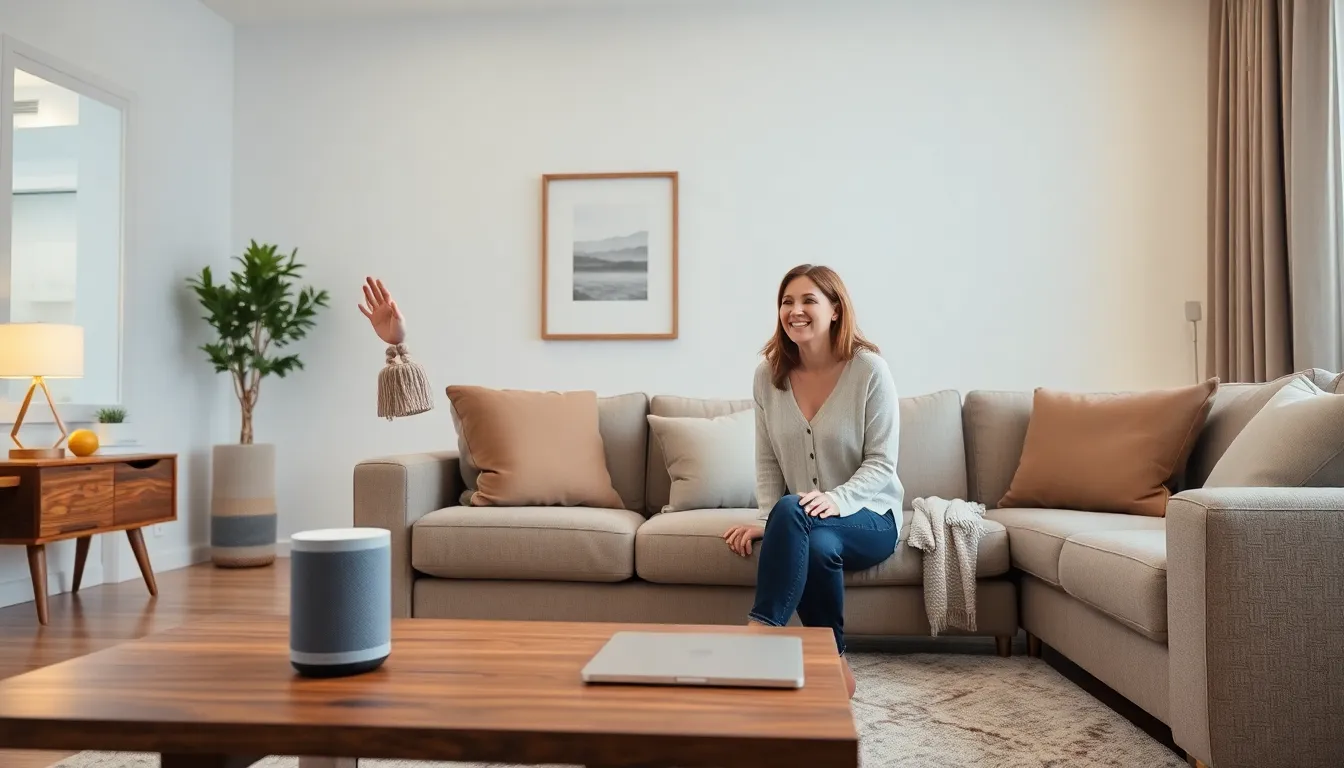Imagine walking into your home and effortlessly commanding your lights to dim or your music to play just by speaking. Voice-controlled home features have transformed the way people interact with their living spaces, making everyday tasks simpler and more efficient. This technology not only enhances convenience but also adds a touch of modern sophistication to any home.
As smart home devices become increasingly popular, understanding the benefits and possibilities of voice control is essential. From managing home security to adjusting the thermostat, these features empower users to create a personalized living experience. Discover how voice-controlled technology is revolutionizing homes and making life easier for everyone.
Table of Contents
ToggleOverview of Voice-Controlled Home Features
Voice-controlled home features facilitate seamless interaction with smart devices using voice commands. This technology encompasses various applications, enhancing convenience and efficiency in daily tasks.
- Smart Assistants
Smart assistants, such as Amazon Alexa and Google Assistant, serve as the central hub for voice control. They process voice commands and execute tasks ranging from playing music to managing schedules. These assistants integrate with numerous devices for cohesive functionality.
- Lighting Control
Voice-controlled lighting systems allow users to adjust brightness, colors, and on/off states effortlessly. Systems like Philips Hue and LIFX respond to commands, promoting energy conservation and tailoring ambiance for different occasions.
- Security Monitoring
Voice controls enhance home security through systems like Ring and Arlo. Users can check camera feeds, lock doors, and receive alerts about suspicious activity via voice commands, increasing safety and peace of mind.
- Thermostat Management
Smart thermostats, including Nest and Ecobee, enable temperature adjustments through voice. Users can set schedules, switch modes, and optimize energy usage, ensuring a comfortable home environment.
- Media Control
Voice command capabilities extend to media devices. Users can play, pause, or skip tracks on platforms like Spotify and Netflix without remote controls, making entertainment more accessible.
- Kitchen Appliances
Voice control simplifies cooking tasks with smart kitchen appliances. Users can set timers, adjust settings, and inquire about recipes through devices, enhancing culinary experiences.
- Home Integration
Integrating all voice-controlled devices creates a comprehensive smart home network. Users can set routines that trigger multiple actions with a single command, streamlining operation and improving user experience.
Voice-controlled home features hold significant potential, transforming living spaces into more accessible, efficient, and secure environments.
Benefits of Voice-Controlled Home Features

Voice-controlled home features offer significant advantages, enhancing the quality of life by simplifying daily tasks. These benefits include increased convenience, improved accessibility, and energy efficiency.
Convenience and Accessibility
Convenience stands out as a primary benefit of voice-controlled home features. Users can perform tasks hands-free, such as adjusting the thermostat or controlling lights, resulting in streamlined daily routines. Accessibility improves significantly for individuals with mobility challenges or disabilities, enabling them to manage their environment effortlessly. Voice commands allow for quick adjustments, such as turning on appliances or locking doors, with minimal effort required.
Energy Efficiency
Energy efficiency plays a crucial role in the benefits of voice-controlled home features. Smart thermostats allow users to optimize heating and cooling based on real-time occupancy data, reducing energy waste. Voice control for lighting ensures that users can turn off lights in unoccupied rooms, contributing to lower electricity bills. Additionally, voice-controlled smart plugs enable monitoring of energy consumption for various devices, facilitating smart usage decisions and promoting eco-friendly habits.
Popular Voice-Controlled Home Devices
Voice-controlled home devices enhance daily routines by providing seamless control through voice commands. Various devices offer specific functionalities that contribute to a smart home environment.
Smart Speakers
Smart speakers serve as the central control units for voice-activated home ecosystems. Devices like Amazon Echo and Google Nest Audio enable users to play music, set reminders, and answer questions using simple voice commands. These speakers integrate with various smart home devices, allowing hands-free control of lighting, thermostats, and security systems. Moreover, voice assistants such as Alexa and Google Assistant can provide real-time information, facilitating task management and home automation with ease.
Smart Lighting
Smart lighting solutions empower users to enhance their home environments with customizable settings. Products such as Philips Hue and LIFX allow voice activation for turning lights on and off, adjusting brightness, and changing colors. Integration with smart speakers enables users to program lighting schedules and control multiple lights simultaneously with voice commands. This technology not only improves ambiance but also contributes to energy savings by reducing usage when rooms are unoccupied.
Integration with Home Automation Systems
Voice-controlled home features integrate seamlessly with various home automation systems, enhancing user experience and control.
Compatibility with Other Devices
Compatibility is crucial for effective integration of voice-controlled features with home automation systems. Many popular smart devices, including bulbs, thermostats, and security cameras, are designed to work with leading voice assistants like Amazon Alexa and Google Assistant. This wide compatibility allows users to mix and match devices from different manufacturers—Philips Hue lights can pair with Nest thermostats to create a cohesive smart environment. Additionally, hubs like SmartThings or Apple HomeKit bring diverse devices together, enabling centralized control through voice commands.
Setting Up Voice Control
Setting up voice control in a home automation system is a straightforward process. First, users must connect their voice assistant to the home Wi-Fi network. Next, they should add compatible devices through their respective apps, following step-by-step prompts. After completing setup, users can assign custom names to devices for easier voice recognition. For example, naming a smart lamp “Living Room Light” simplifies commands—users can say, “Turn on the Living Room Light.” Finally, routines or automations can be created in the app, allowing multiple devices to respond to a single command, streamlining interactions within the smart home ecosystem.
Security and Privacy Considerations
Voice-controlled home features introduce significant security and privacy considerations that users must address. Concerns about data protection and unauthorized access to personal information arise with the integration of smart devices.
Data Security
Data security plays a crucial role in voice-controlled environments. Most devices require user data for functionality, including voice samples and preferences. Users must choose devices with robust encryption protocols to protect their information. For example, devices that utilize advanced encryption standards (AES) provide a greater layer of security against potential breaches.
User Authentication
User authentication enhances security for voice-controlled systems. Implementing multi-factor authentication (MFA) reduces the risk of unauthorized access. Voice recognition technology should undergo regular updates to improve accuracy and minimize vulnerabilities. Users can set up PINs or engage biometric options, adding layers of protection beyond voice commands.
Privacy Policies
Privacy policies fundamentally influence how personal data is managed. Users must review manufacturers’ privacy policies to understand data usage, storage, and sharing practices. Selecting companies that prioritize user privacy and provide clear data management options is crucial. For instance, brands that offer opt-out features for data collection empower users to control their information.
Device Monitoring
Device monitoring supports security for voice-controlled features. Users should regularly check connected devices for unfamiliar access or settings. Many smart devices come with monitoring tools that alert users to unauthorized attempts. Implementing network security practices, such as using strong passwords and securing home Wi-Fi networks, fortifies the overall security posture.
Regular Updates
Regular updates maintain the security of voice-controlled devices. Manufacturers frequently release software updates that address vulnerabilities and enhance security features. Users must enable automatic updates or periodically check for updates to ensure devices remain secure.
Limitations of Voice Recognition
Limitations of voice recognition technology present security challenges as well. Misinterpretations of commands can lead to unintended actions, which might create vulnerabilities. Users can reduce risks by implementing device settings that require confirmation before executing sensitive commands, especially relating to security features like locking doors or activating alarms.
By considering these factors, users can enjoy the benefits of voice-controlled home features while safeguarding their privacy and data security.
Voice-controlled home features are revolutionizing the way people interact with their living spaces. This technology not only enhances convenience but also promotes energy efficiency and accessibility. As smart home devices continue to evolve, users can expect even more seamless integration and functionality.
By embracing voice control, individuals can simplify their daily routines and create a personalized environment tailored to their needs. However, it’s essential to remain vigilant about security and privacy, ensuring that the benefits of this technology are enjoyed without compromising safety. With the right precautions, voice-controlled home features can significantly enhance quality of life, making homes smarter and more responsive than ever before.



